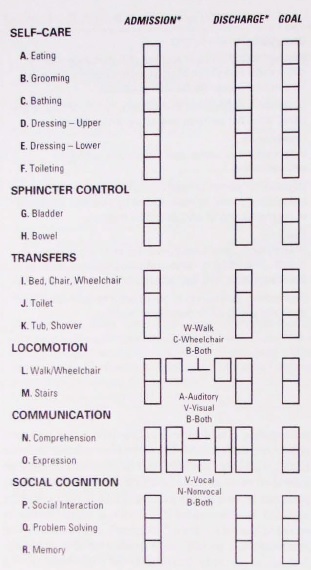Functional Independence Measure (FIM)
Original Editor - Ajay Upadhyay
Top Contributors - Laura Ritchie, Gayatri Jadav Upadhyay, Ajay Upadhyay, Lucinda hampton, Nikhil Benhur Abburi, Kim Jackson, Lauren Lopez, Kapil Narale, Evan Thomas, WikiSysop, Vidya Acharya and Nicole Hills
Objective[edit | edit source]
The Functional Independence Measure (FIM ) is an 18- Item of physical, psychological and social function.
Intended Population[edit | edit source]
In any motor impairment associated with any condition
Method of Use[edit | edit source]
The FIM uses the level of assistance an individual needs to grade the functional status of a person. Grading is given as total independence to total assistance. Irrespective of the use of any assistive device, the person is considered complete independence.
The list includes six self care activities:
- Feeding
- Grooming
- Bathing
- Upper Body Dressing
- Lower Body Dressing
- Toileting
The FIM Measures what an individual can perform and not what that person could do under certain circumstances.
FIM Levels
No Helper
7. Complete Independence
(Timely, Safety)
6. Modified Independence
(Device)
Helper - Modified Dependence
5. Supervision
(Subject = 100%)
4. Minimal Assistance
(Subject = 75% or more)
3. Moderate Assistance
(Subject = 50% or more)
Helper - Complete Dependence 2. Maximal Assistance
(Subject = 25% or more)
1. Total Assistance or not Testable
(Subject less than 25%)
- Leave no blanks. Enter 1 if not testable due to risk.
Reliability[edit | edit source]
Inter-Rater Reliability (Intraclass co-relation coefficients ranging from 0.86 to 0.88)
Validity[edit | edit source]
The concurrent validity with Barthel Index (ICC > 0.83)







